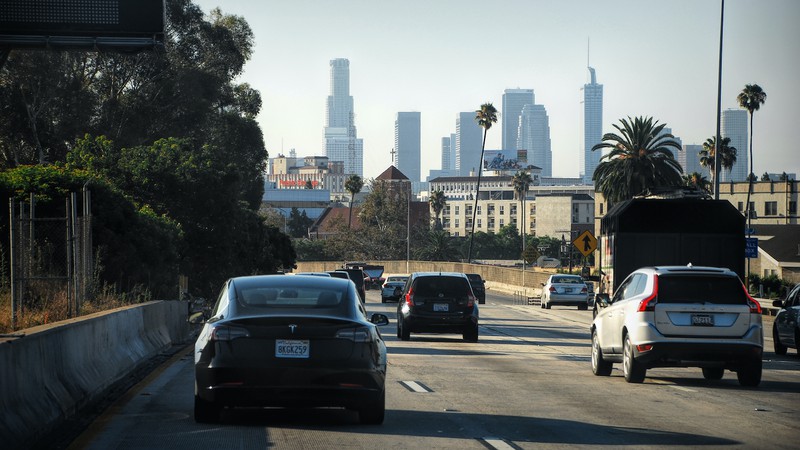City council rejected the “Healthy Streets L.A” initiative. Now it’s up to Angeleno voters.

Los Angeles voters can take a step toward reducing traffic violence with a measure on the March ballot. 4X4 Blazer 1776 / Wikimedia Commons Creative Commons Generic license 2.0
In 2022, a year in which 312 people died in Los Angeles traffic—more than half, 159, pedestrians—the city council in California’s largest city took up a measure that would have required the city to put new traffic safety features in place whenever it repaved a street.
Under Measure HLA, any time the city does improvement work on a stretch of street at least 660 feet long, it must put elements of the Mobility Plan in place, such as widening sidewalks, and adding both bicycle and bus lanes.
The 15-member council rejected it.
Perhaps not surprisingly, 2022’s traffic fatality numbers, the worst in 20 years, only got even worse in 2023. That year, 330 human beings lost their lives in L.A. traffic, according to police statistics (the numbers did not yet include the final week of 2023). Now, in 2024, the measure, known as “Healthy Streets L.A.,” will get another chance, and this time the verdict will be up to Los Angeles voters.
Human Life vs. Human Convenience
On the March 5 primary election ballot, Angelenos will cast yay or nay votes on Measure HLA, the City Mobility Plan Implementation Initiative, which requires the city to prioritize safety measures in the 2015 plan, which included the city’s adoption of Vision Zero, the international initiative to eliminate traffic deaths completely. The Los Angeles version of Vision Zero calls for traffic deaths to reach zero by 2035.
A 2022 study by the Harvard and Boston University schools of public health found that Black and Hispanic Americans are victims of traffic violence and substantially greater rates than whites in America.
Under Measure HLA, any time the city does improvement work such as paving on a stretch of street at least 660 feet long, it must put elements of the Mobility Plan in place along that stretch. The measures include widening sidewalks, and adding both bicycle and bus lanes.
Residents have a green light to sue the city, under the measure’s provisions, if it neglects to put Mobility Plan improvements in place when doing road improvements.
Supporters of Measure HLA, including the nonprofit Streets for All, say they hope to spend $2 million to get the initiative passed by voters in March, according to a a report by Los Angeles Times transportation writer Rachel Uranga. But the battle between backers and foes of the measure highlight the tensions between two fundamental principles: human life, and human convenience.
Racial Equity in Reducing Traffic Deaths
“The way we have designed our city and our streets are killing us,” Streets for All founder Michael Schneider told the Times.
From 2015 to 2022, the city of Los Angeles has implemented only 3 percent of the projects called for in its own Mobility Plan, according to a Los Angeles Times report.
Christopher LeGras, co-director of KeepLAMoving which opposes the measure, told Uranga that HLA will make commutes longer, traffic heavier, and slow down first-responder response times.
The measure’s opponents, however, also say that the proposed law as written does not do enough to resolve ethnic and income disparities in traffic violence rates. A 2022 study by the Harvard and Boston University schools of public health found that Black and Hispanic Americans are victims of traffic violence and substantially greater rates than whites in America.
According to the study, on a per-mile-traveled basis, Black Americans are twice as likely to be killed by moving vehicles while walking, and four times as likely while cycling. Death rates for Hispanic Americans were somewhat lower, but still worse than for whites.
When the sun goes down, being a pedestrian becomes even more deadly for Black people, whose fatality rate jumps to one 3.4 times greater than for whites at night. The sample size for cycling at night was too small to make the data meaningful, according to the study’s authors.
Some city council members said they supported an “alternative” that, while similar to the Healthy Streets L.A. initiative, would place more emphasis on making improvements in lower-income and minority areas.
“Some neighborhoods have smooth sidewalks and streetlights, while other neighborhoods people have to walk in the dark on dirt sidewalks,” the council’s then-President Nury Martinez said at the time of the 2022 vote, according to the Times. “We need to make sure that the neighborhoods that have gone without are invested in first.”
Martinez was forced to resign in October, 2022—about two months after the Healthy Streets vote—when a leaked audio recording captured her, and other council members, making a wide range of racist remarks in a private conversation, including Martinez using the word “changuito,” which means “little monkey” in English, to refer to the Black son of a fellow council member.
From 2015 to 2022, the city of Los Angeles has implemented only 3 percent of the projects called for in its own Mobility Plan, according to a Los Angeles Times report.